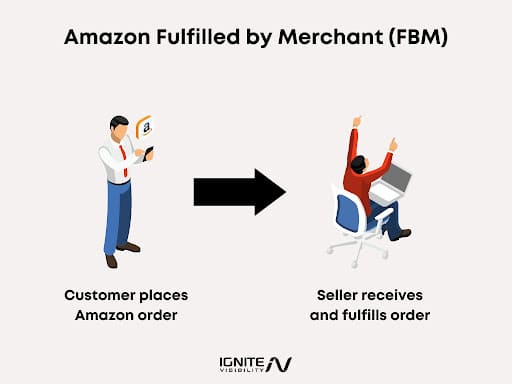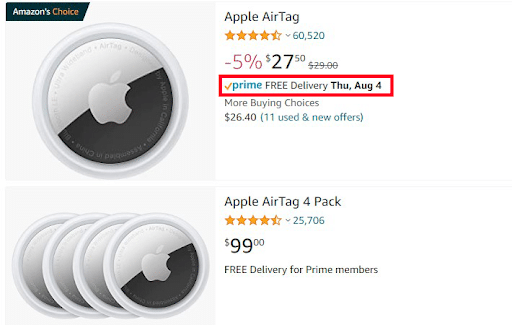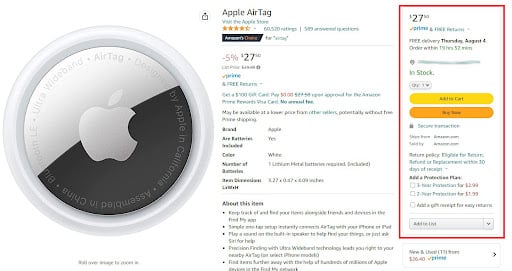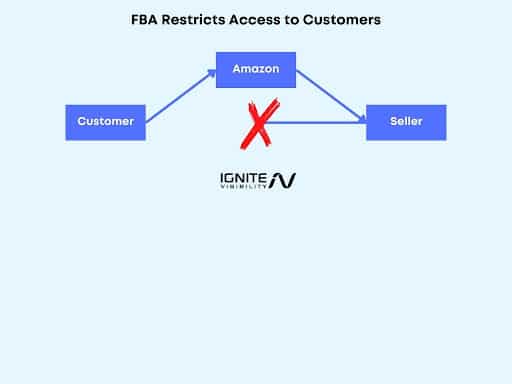Amazon FBA vs. FBM is one of the hottest debates in ecommerce.
Many sellers consider FBA to be the best thing that’s happened to their business. But others think it’s a ripoff and stick to FBM.
This article settles the debate. You’ll learn about both options, their differences, and which is best for your venture.
What is Amazon FBA?
Fulfillment by Amazon lets businesses offload order completion to Amazon. It works like this:
- Sellers label and send their products to Amazon
- Amazon processes and stores the products
- Amazon ships orders when customers place them
- If customers have issues, Amazon handles support and returns
- You receive your profit every two weeks
And best of all, most products qualify for Prime shipping. This leads to higher sales and customer satisfaction.
Using FBA, sellers can offload all their logistics to one of the world’s largest networks. It’s just a matter of making the product, shipping it to Amazon, and counting the money—right?
Mostly, but FBA isn’t free. It charges sellers fees for:
- Storage (especially over 365 days)
- Fulfillment (based on size and weight)
- Product disposal and returns to seller
- Customer returns
- Improper labeling
Businesses with good turnover rates can manage these fees. But if your items are large or sell slowly, they can pinch.
What is Amazon FBM?
Fulfilled by Merchant (FBM ) sellers list products on Amazon but handle storage, shipping, and support on their own. It’s like the traditional ecommerce model, only via Amazon.
FBM sellers have full control over fulfillment. They can handle orders themselves or outsource to third-party logistics (3PL).
Amazon FBA vs. FBM: Major Differences
Choosing between FBA and FBM isn’t simple. Depending on your situation, your business can gain or suffer from either choice.
For example, FBA charges fees for items stored over a year. It’s not a problem for sellers who sell quickly, but it can hurt businesses that don’t.
Below, you’ll find a comprehensive guide to the differences between FBA and FBM.
Review these differences and think about each one will affect your business. By the end, you’ll know what option is right for you.
Fulfillment
Any online business worries about fulfillment and logistics. If products don’t get to customers on time, they’ll rate the business poorly and find an alternative.
FBA
After Amazon gets your FBA products, it takes care of everything.
Orders are placed, shipped, returned, and serviced without seller involvement. As long as the seller supplies inventory before it’s sold out, they have nothing to worry about.
Best of all, FBA items get the “Prime” badge in listings. It tells customers the product is eligible for free two-day shipping, leading to 25% more sales.
FBM
FBM places everything in the hands of the merchant. Once Amazon gets the order, it’s the seller’s job to get items to customers however they see fit.
Shipping isn’t a problem as long as you keep up with it. But for some sellers, it’s stressful, costly, and time-consuming.
Alternatively, FBM sellers can outsource shipping to third parties. 3PL services like ShipBob sync with Amazon accounts and fulfill orders as they come.
FBA’s Fulfillment is Faster and Easier
Shipping is a hassle no matter how efficient your operations are. Supplies are expensive, packing is tiresome, and delays are unpredictable.
FBA eliminates the logistics question. Instead of sweating in their warehouse, sellers can sip smoothies in Cancun.
And while they’re an alternative to FBA, 3PLs don’t get you Prime listings. This means missing out on higher margins and more sales.
Inventory Storage
All businesses need a place to store and ship products. While small operations can do this from home, businesses looking to scale must find space to store inventory.
FBA
With FBA, Amazon handles all your inventory.
There are fees, but they’re generally less than warehousing. No costs for shelves, equipment, labor, or time—just a flat rate based on volume.
That said, you’ll need to be mindful of expenses, or they’ll reduce your margins. Charges can mount up fast if your items are too large or don’t sell fast enough.
FBA also has dynamic storage limits, making life difficult for larger sellers.
Amazon can announce inventory reductions over 50% without notice. And when that happens, sellers have no choice but to accept the change as best they can.
FBM
FBM makes inventory your responsibility.
If you only sell a couple dozen products monthly, you can store items in your home. But if you’re looking to scale, inventory becomes a serious concern.
Your options are:
- Purchasing/renting storage space
- Using a 3PL service
Using your own space gives you the most control.
While 3PLs are more streamlined, anything can happen to your product (delays, business shutdown, etc.). 3PLs are also hit or miss—some provide great services, others nightmares.
Personal storage comes with its problems too. Besides paying for space, you need packing supplies, equipment, and labor.
No Clear Choice for Storage
Both FBA and FBM inventory management have pros and cons.
Letting Amazon handle your storage seems easy. Pay a flat rate, and they store and ship your products without stress.
But storage costs hurt small operations, and storage limits hurt large ones. Your business may work best with it if it’s somewhere in the middle.
In contrast to FBA, FBM gives you full control. But that comes with the responsibility of managing all inventory yourself.
For small businesses, “inventory” might mean keeping stuff in the garage. But for larger ones, it means paying for space, packing, labor, and security.
Ultimately, the best storage choice depends on your inventory and turnover:
- Low inventory/ turnover: FBM because FBA storage fees will reduce margins and turnover won’t compensate for it
- Medium inventory/turnover: FBA because you won’t have issues with long-term fees or storage limits. Don’t list anything that won’t sell quickly
- High inventory/turnover: Hybrid model of FBA and FBM. Spreading fulfillment across different channels makes you less vulnerable to storage limits
Turnover and Amazon Prime
It’s no contest: FBA makes more sales than FBM, thanks to Amazon Prime.
When shoppers see the Prime logo over a listing, they know they’ll get:
- Two-day shipping (or faster)
- No-questions-asked returns
- Good customer service
This leads to massively higher sales versus non-Prime listings.
On the side of Amazon’s product listings is the “Buy Box.” It lets customers add products to their cart without sifting through sellers.
Thanks to Prime’s quality, Amazon is likelier to select FBA listings for the Buy Box than non-Prime. Regularly winning it means tons more sales.
Alternative for FBM Merchants: Seller-Fulfilled Prime (SFP)
SFP lets FBM merchants list Prime products without using FBA. This gives you all the above benefits without FBA’s restrictions.
Enrolling in SFP isn’t easy—you’ll need to meet these requirements:
- 99% of orders shipped on time
- At least 98.5% of orders shipped with Amazon Buy
- Cancellations of less than 0.5%
You’ll also hand over customer support to Amazon—including return rules. But in exchange, you get control over inventory and packaging.
Fees: Amazon FBA vs. FBM
Both FBM and FBA sellers pay the Amazon Referral Fee—a commission on all products sold. It ranges from 6-20%, varying by category (technology, fashion, kitchen, etc.)
In addition, all sellers pay for one of two selling plans:
- Individual: $0.99 per item sold
- Professional: $39.99 per month
The individual plan is fine for sellers handing a few items a month. But once ready to scale, you’ll need a Professional plan.
Amazon charges several more fees for FBA.
FBA Fees
FBA fees are dynamic, varying based on:
- Size of product
- Season
- Product weight
- And more
There are many different types, as explained below.
Inventory Storage Fees
Amazon charges FBA sellers for storage based on item volume and length of storage (short, medium, and long term).
It’s easiest to think of storage fees in pallet terms.
How many of your products fit on a pallet? How much does it cost Amazon to store that pallet in their warehouse?
The more pallets your items occupy, the more your fees will be. This is why many sellers fulfill large items themselves.
Fulfillment Fees
Amazon bills all handling, packing, and shipping expenses as the Fulfillment Fee. Like inventory storage, it varies mainly by product size.
A larger product takes up more room on a delivery truck, reducing Amazon’s margins. As a result, larger items have hefty fees, while smaller ones are more affordable.
Return Fees
FBA sellers have to pay a fee whenever a customer returns an item. And thanks to Amazon’s generous policy, returns are more common than FBM.
Penalty Fees
Amazon sets strict guidelines to keep fulfillment running smoothly. Sellers who fail to pack and label items properly will pay fees for Amazon to fix the mistakes.
Package Prep Fees
Sellers who want to avoid penalty fees can pay Amazon to prep packages. This makes FBA more expensive, but it’s helpful for businesses trying to move items quickly.
Product Removal Fees
Sellers who stop using FBA have two options for their leftover inventory:
- Pay Amazon to return them
- Pay Amazon to destroy them
Each incurs a fee, with returns being more expensive.
FBM Fees
FBM sellers only pay referral and seller plan fees as described above. It’s one of the FBM selling strategy’s main benefits.
Are FBA Fees Worth It?
Using FBA to its full potential can save sellers up to 30% on shipping costs. As long as you’re shipping small-to-medium items with high enough velocity, FBA fees are more than worth it.
Customer Interaction
Engaging with customers is a crucial part of building repeat business. Next, you’ll learn how FBA and FBM allow you to interact with them.
FBA
By joining FBA, your business becomes part of Amazon.
You give up a lot of control in exchange for its logistical network. As a result, FBA sellers have virtually no interaction with customers.
No Customer Information
In 2021, Amazon ensured FBA sellers had no access to customer details (besides snippets for tax reasons). This prevents all remarketing.
No Branded Packaging
Amazon handles packaging and only allows a small slip requesting an Amazon review. In contrast to Amazon’s branded packaging, your business gets no exposure.
No Customer Support
While outsourcing customer support to Amazon is helpful, it prevents customer contact.
FBM
In contrast to FBA, FBM merchants get:
- Access to customer information (with guidelines for use)
- Looser restrictions on packaging
- Customer support interactions
Instead of being a box on a customer’s doorstep, your brand can build connections with them.
FBA Restricts Customer Interaction, But Does it Matter?
While FBA prohibits contact with customers, most sellers don’t care. Their concern is pleasing Amazon—not thousands of random people.
If you’re looking to build lasting relationships with your customers, FBM is better. Otherwise, FBA’s restrictions won’t make much difference.
Returns
While FBA and FBMs offer 30-day refunds, how they handle returns differs.
Amazon handles FBA returns. They’re fast, easy, and barely scrutinized. This encourages customers to make returns more often—which they do.
Unlike Amazon’s automated system, FBM returns involve contact with real people. Sellers control whether or not to issue refunds (according to Amazon policy).
This makes customers less likely to ask for returns. When they do, sellers review them more closely than Amazon, making it harder to game the system.
Amazon FBA vs. FBM Verdict: It Depends!
Choosing between FBA and FBM depends on your specific situation.
Large businesses can face severe FBA storage limits, making a hybrid model necessary. Small accounts with low order volumes get hurt by storage fees, making FBM the better choice.
It comes down to what option suits you best. If you’re still unsure, test both channels with different products. Amazon gives you the freedom to choose without committing—use it.






